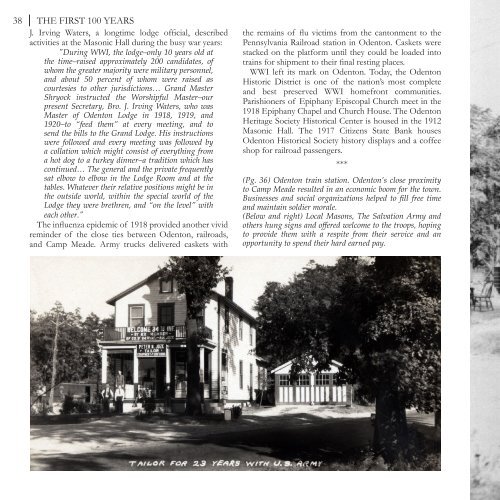Fort George G. Meade: The First 100 Years
You may know Fort George G. Meade as a cyber and intelligence hub, but did you know that the installation used to be the home of Army Tank School after World War I? Or that it housed an internment camp at the start of World War II for primarily German-American and Italian-American citizens and foreign nationals? Learn more about the fascinating history of the third largest Army base in the U.S. in terms of number of workforce in this book.
You may know Fort George G. Meade as a cyber and intelligence hub, but did you know that the installation used to be the home of Army Tank School after World War I? Or that it housed an internment camp at the start of World War II for primarily German-American and Italian-American citizens and foreign nationals? Learn more about the fascinating history of the third largest Army base in the U.S. in terms of number of workforce in this book.
You also want an ePaper? Increase the reach of your titles
YUMPU automatically turns print PDFs into web optimized ePapers that Google loves.
38 THE FIRST <strong>100</strong> YEARS<br />
J. Irving Waters, a longtime lodge official, described<br />
activities at the Masonic Hall during the busy war years:<br />
"During WWI, the lodge–only 10 years old at<br />
the time–raised approximately 200 candidates, of<br />
whom the greater majority were military personnel,<br />
and about 50 percent of whom were raised as<br />
courtesies to other jurisdictions… Grand Master<br />
Shryock instructed the Worshipful Master–our<br />
present Secretary, Bro. J. Irving Waters, who was<br />
Master of Odenton Lodge in 1918, 1919, and<br />
1920–to “feed them” at every meeting, and to<br />
send the bills to the Grand Lodge. His instructions<br />
were followed and every meeting was followed by<br />
a collation which might consist of everything from<br />
a hot dog to a turkey dinner–a tradition which has<br />
continued… <strong>The</strong> general and the private frequently<br />
sat elbow to elbow in the Lodge Room and at the<br />
tables. Whatever their relative positions might be in<br />
the outside world, within the special world of the<br />
Lodge they were brethren, and “on the level” with<br />
each other."<br />
<strong>The</strong> influenza epidemic of 1918 provided another vivid<br />
reminder of the close ties between Odenton, railroads,<br />
and Camp <strong>Meade</strong>. Army trucks delivered caskets with<br />
the remains of flu victims from the cantonment to the<br />
Pennsylvania Railroad station in Odenton. Caskets were<br />
stacked on the platform until they could be loaded into<br />
trains for shipment to their final resting places.<br />
WWI left its mark on Odenton. Today, the Odenton<br />
Historic District is one of the nation’s most complete<br />
and best preserved WWI homefront communities.<br />
Parishioners of Epiphany Episcopal Church meet in the<br />
1918 Epiphany Chapel and Church House. <strong>The</strong> Odenton<br />
Heritage Society Historical Center is housed in the 1912<br />
Masonic Hall. <strong>The</strong> 1917 Citizens State Bank houses<br />
Odenton Historical Society history displays and a coffee<br />
shop for railroad passengers.<br />
***<br />
(Pg. 36) Odenton train station. Odenton’s close proximity<br />
to Camp <strong>Meade</strong> resulted in an economic boom for the town.<br />
Businesses and social organizations helped to fill free time<br />
and maintain soldier morale.<br />
(Below and right) Local Masons, <strong>The</strong> Salvation Army and<br />
others hung signs and offered welcome to the troops, hoping<br />
to provide them with a respite from their service and an<br />
opportunity to spend their hard earned pay.


